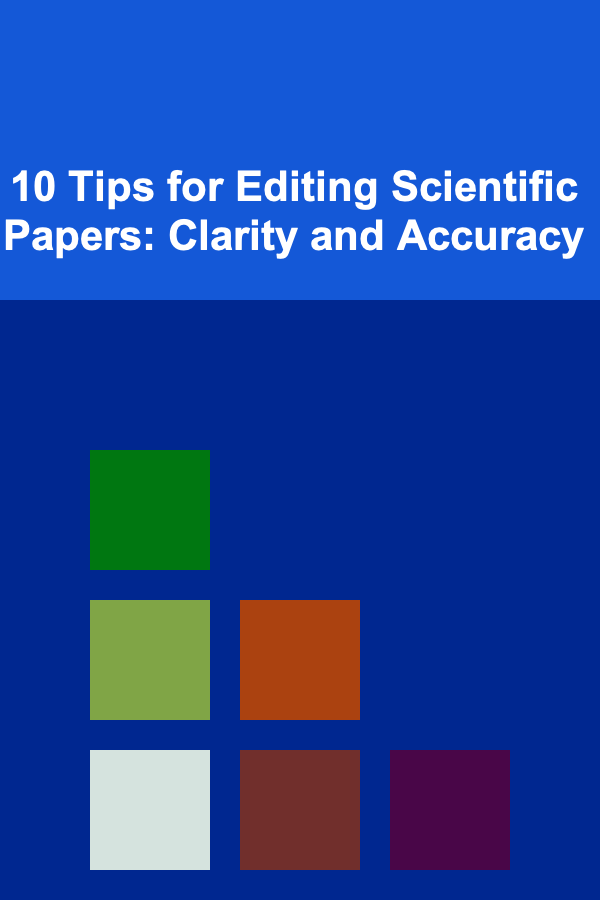
10 Tips for Editing Scientific Papers: Clarity and Accuracy
ebook include PDF & Audio bundle (Micro Guide)
$12.99$11.99
Limited Time Offer! Order within the next:

Editing scientific papers is a crucial step in ensuring the quality and integrity of research. A well-edited paper is clear, concise, and accurate, which enhances its chances of being accepted for publication and ensures that the research communicates its findings effectively. In this article, we explore ten essential tips for editing scientific papers, with a focus on improving clarity and accuracy. These tips will help authors refine their manuscripts, making them more readable and impactful while adhering to the rigorous standards of academic publishing.
Understand the Target Audience
The first step in editing a scientific paper is understanding who will read it. Is the paper intended for specialists in the field, or is it aimed at a broader audience? A paper for an interdisciplinary journal may require different editing than one for a highly technical publication. Understanding the target audience helps determine the level of detail, technical language, and explanations needed.
If the paper is intended for a general audience or researchers from other disciplines, it's important to provide sufficient context for complex ideas and avoid jargon that might be unfamiliar. On the other hand, a paper for specialists can be more technical and assume that readers have a strong background in the field.
Focus on Structure and Flow
The structure of a scientific paper plays a key role in its readability. The typical structure of a scientific paper includes the following sections: abstract, introduction, methods, results, discussion, and conclusion. Each section has a specific purpose and should be clearly demarcated in the manuscript.
During editing, ensure that each section flows logically into the next. For example, the introduction should clearly set up the research question, followed by a methods section that explains how the research was conducted. The results section should present the findings, and the discussion should interpret those findings in the context of existing literature.
Moreover, make sure that there are smooth transitions between paragraphs and sections, guiding the reader through the paper's narrative. Transitions should help clarify the relationships between ideas, such as how the methods lead to the results and how the results contribute to the broader understanding of the topic.
Simplify Complex Sentences
Scientific writing can sometimes become convoluted due to long, complex sentences. While it's important to be precise, clarity should never be sacrificed for complexity. Break down overly long sentences into smaller, more digestible parts.
Look for places where sentences can be simplified without losing meaning. For example, instead of saying, "Due to the fact that the experiment was designed in such a way that it could be conducted under controlled conditions, it resulted in more accurate data," you can write, "The experiment was designed to be conducted under controlled conditions, resulting in more accurate data."
Shorter sentences not only improve readability but also make the paper more engaging. Readers are more likely to follow the argument if they can easily understand each point.
Ensure Consistency in Terminology
Consistency in the use of terminology is essential for scientific writing. Inconsistent terminology can confuse readers and obscure the meaning of key concepts. For example, if you use terms like "protein A" and "enzyme X" interchangeably, ensure that these refer to the same entity throughout the paper.
To ensure consistency, create a list of key terms and definitions as you write and refer to it throughout the editing process. Additionally, ensure that abbreviations are introduced correctly and are used consistently. If you abbreviate a term like "deoxyribonucleic acid" as "DNA" in one section, do so consistently in all subsequent sections.
Check for Clarity in Hypotheses and Objectives
The hypothesis or research question is the foundation of any scientific paper. It should be clearly stated early on in the introduction and should guide the direction of the entire study. When editing, make sure that the research question or hypothesis is precise, clearly articulated, and easy to understand.
Avoid vague or overly broad hypotheses. A well-constructed hypothesis is specific and testable. For example, rather than stating "This study examines the effects of X on Y," specify what aspect of X you are studying and what particular outcome of Y you are focusing on.
Verify Data Presentation and Accuracy
One of the most critical aspects of scientific writing is the accuracy of data presentation. Any errors in data interpretation or misrepresentation of findings can undermine the entire study. During the editing process, double-check all figures, tables, and charts to ensure they accurately represent the data.
Ensure that all data points are correctly labeled, that statistical analyses are accurate, and that units of measurement are consistent throughout the paper. If the paper includes equations or mathematical models, verify that the formulas are correct and that all variables are defined clearly.
If necessary, cross-check with original data sets or consult with colleagues to confirm that the results are presented accurately.
Improve Transitions Between Results and Discussion
The results and discussion sections of a paper are where the research findings are presented and interpreted. These sections should be tightly linked, with a clear narrative connecting the results to their implications.
When editing, ensure that the discussion doesn't simply repeat the results but expands on them. Instead of merely restating the data, explain what the results mean in the context of the research question and how they compare with previous studies. This provides depth and insight, guiding readers toward the paper's conclusions.
Eliminate Redundancy and Unnecessary Words
Scientific writing should be concise and to the point. Redundant phrases or excessive verbiage can dilute the impact of the message and make the paper unnecessarily long. During editing, eliminate any repetitive phrases, such as "due to the fact that" when "because" will suffice. Also, remove unnecessary adjectives or adverbs that don't add significant meaning.
For instance, instead of writing "It is important to note that the results are statistically significant," simply say, "The results are statistically significant." This keeps the writing direct and focused.
Ensure Proper Citation and Referencing
Proper citation is essential for academic integrity and avoiding plagiarism. Make sure that all sources referenced in the paper are properly cited according to the appropriate citation style (e.g., APA, MLA, Chicago, or a journal-specific style). During editing, ensure that all in-text citations are matched with the correct entries in the reference list.
Also, check that the citations are relevant and up-to-date. Avoid citing sources that are not directly related to your work, and ensure that each citation adds value to the discussion. Inaccurate or incomplete citations can significantly detract from the credibility of your paper.
Proofread for Grammar, Punctuation, and Style
Finally, a thorough proofreading of the paper is essential. Grammar, punctuation, and style errors can detract from the professionalism and readability of the paper. Common issues to check for include:
- Subject-verb agreement
- Correct use of commas, semicolons, and colons
- Proper sentence structure and paragraphing
- Consistency in spelling and formatting
It's also helpful to read the paper aloud to catch awkward phrasing or missing words. Sometimes, hearing the text can reveal issues that are not immediately apparent when reading silently.
Conclusion
Editing a scientific paper requires a careful balance of clarity, accuracy, and precision. By focusing on the target audience, ensuring consistency in terminology, simplifying complex sentences, and presenting data accurately, authors can significantly improve the quality of their manuscript. Additionally, eliminating redundancy, improving transitions between sections, and proofreading for grammar and punctuation will further enhance readability.
By following these ten tips, researchers can ensure that their scientific papers are polished, professional, and ready for submission. Whether the goal is publication in a high-impact journal or sharing findings with a broader audience, effective editing is the key to making a lasting impact with your research.
Reading More From Our Other Websites
- [Needle Felting Tip 101] How to Achieve Precise Geometric Patterns in Needle Felting for Modern Home Décor
- [Organization Tip 101] How to Organize Your Kitchen for Efficient Meal Prep
- [Organization Tip 101] How to Establish an Annual Home Inventory Review
- [Personal Care Tips 101] How to Make Sure Your Teeth Whitening Strips Don't Irritate Your Lips
- [Personal Care Tips 101] How to Make Your Own Facial Cleanser for Sensitive Skin
- [Organization Tip 101] Best Organization Tools for Project Management
- [Home Security 101] How to Monitor Your Home's Security Remotely with Mobile Apps
- [Screen Printing Tip 101] From Blank Canvas to Profit: Starting Your Own Screen Printing Business
- [Whitewater Rafting Tip 101] Seasonal Guides: When and Where to Raft for the Best Water Conditions
- [Home Rental Property 101] How to Leverage Seasonal Demand for Higher Rent

How to Keep Your Apartment Clutter-Free All Year Round
Read More
How to Plan a Family DIY Birdhouse Building Project
Read More
How to Use Plant Stands for an Organized Green Space
Read More
How To Protect Your Brain from Environmental Toxins
Read More
How to Build Early Math Skills with Everyday Activities
Read More
How to Reduce Food Waste While Eating Healthy
Read MoreOther Products

How to Keep Your Apartment Clutter-Free All Year Round
Read More
How to Plan a Family DIY Birdhouse Building Project
Read More
How to Use Plant Stands for an Organized Green Space
Read More
How To Protect Your Brain from Environmental Toxins
Read More
How to Build Early Math Skills with Everyday Activities
Read More